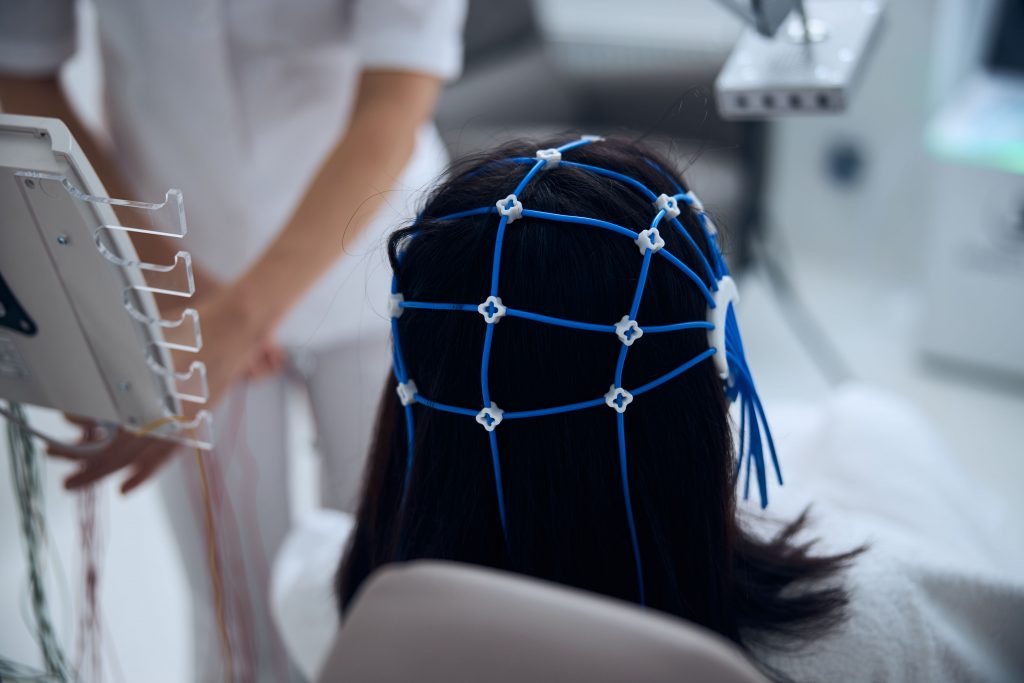Science shows the importance of setting and achieving goals for those living with a disability.
“Disability need not be an obstacle to success”, wrote Stephen Hawking in the opening line of the World Disability report in 2011 (1). As one of the most prominent scientists to ever live, he’s not wrong. He advanced our understanding of black holes, proved that time—believe it or not—had a beginning, and provided the most compelling evidence we have that time travel is impossible. He also wrote numerous best sellers and even appeared on multiple episodes of the Simpsons. He was an ambassador for people with disabilities and regularly educated the public on physics, as well as his neurological condition, Amyotrophic Lateral Sclerosis (ALS). He was an inspiration to what a goal-orientated mindset can do.

And Stephen Hawking isn’t the only person who thought a disability was not an obstacle to success. Helen Keller was deaf and blind, and America’s first ‘Goodwill Ambassador’ while writing nearly 500 speeches throughout her life. Frida Kahlo was born with spina bifida, and she grew up to become one of the world’s most prolific 20th-century painters. And Elon Musk is the tech-billionaire with autism who founded Tesla, SpaceX and Neurolink, and is the person who will most likely take us to Mars one day.
Why Goals Are Important.
What’s something these successful people have in common? They set ambitious, well-defined goals.

In fact, having clear, meaningful goals may be an essential component for a happy life. In a paper written by the University of Illinois at Chicago titled ‘The disability paradox: high quality of life against all odds’, sociologists observed that people with disabilities consistently reported having a high quality of life while living with their health conditions. The scientists reason that people with disabilities “learn what is possible and set goals” around that (2). They often conserve their energy for where they need it and search for resources and knowledge to make their lives better. They seek to educate others about their disabilities and maintain strong social networks and long reciprocal relationships. Comparatively, the participants who reported experiencing low quality of life often had no goals directing them, living in “unpredictable and disordered worlds” where they were unable to manage—or lived in environments that exacerbated—their conditions.
There is a mountain of evidence demonstrating the importance of setting goals for people with disabilities. A systematic review by the Review Journal of Autism and Developmental Disorders collated 38 studies on the topic and found that self-setting goals aided participants on the autism spectrum to achieve greater independence (3). The researchers found that while individuals with autism often can excel in academic or vocational settings, difficulties with planning and organisation presented them with a challenge reaching their potential. However, the researchers highlighted that the skills required to set and attain goals can be learned over time with deliberate practice, and this resulted in greater autonomy for the individuals involved. Aside from the improvement to academic and vocational performance, participants also developed better social skills. Notably, being taught how to set their ambitions and correct their own behaviour was key to their success, and participants valued taking the initiative to determine their goals and monitor their behaviour with minimal given feedback.
A similar meta-analysis (considered the highest form of study) titled ‘A Meta-Analysis of Interventions to Promote Self-Determination for Students with Disabilities’ found that students with disabilities who plan and set goals are “better prepared to make purposeful decisions and choices” (4). The researchers pointed out that promoting self-determination, which involved teaching skills like planning, goal setting, self-management, and general problem solving, resulted in reports of increased self-awareness and greater personal initiative when it came to making choices about the future. The effects were noticeable in as little as two weeks, with eight weeks of four thirty-minute study sessions per week dedicated to developing organisational and goal-setting skills giving the best results regardless of gender, grade level, or type of disability.

Vision.
The previously mentioned Hellen Keller once said, “It’s a terrible thing to see, and have no vision!” People who know what direction they wish to take their lives will almost always move in a better direction than those who don’t. Personally, I don’t think I’ve ever met a successful person who couldn’t set visionary goals. This requires some self-awareness and an acknowledgement of one’s self-worth. When teaching students about their disabilities, Gloria Campbell-Whatley of the University of North Carolina found that students who engaged in retrospection and future planning had improved self-images, more honest and forgiving thoughts around their disabilities, and greater insight into what they were capable of (6).
By reflecting on who they are and thinking of the future, these students had a better understanding of what their lives could be like, the steps they would need to take to get there, and how to communicate with others about their needs in pursuit of their goals. They reflected on what others might think of their disabilities and how they could connect with others more effectively. One student said:
“I always wanted to know what to say to a teacher who thought I was being lazy. If I could just tell her what I needed to do to get help. Well, I was able to tell her, and she did not call me lazy.”
These students valued learning more about themselves and developing a clear vision of who and what they could be, and that helped enable them to communicate their needs and move towards their goals.
Audacious.
“My goal is simple”, Hawking said, “It is a complete understanding of the universe, why it is as it is and why it exists at all.” While that answer might sound a little hyperbolic, Hawking was deadly serious, and that may have been the pillar beneath his success. Research shows that audacious goals like Hawking’s are more likely to succeed. For instance, a study by the Journal of Applied Psychology found that families who set more ambitious goals around saving energy (around 20%) were more likely to succeed than those who set more modest goals (5%) (7).
That’s why you should dream big. Your goals direct your attention and mobilise you to act. A goal that is too vague or easy won’t rally your effort like a strong, challenging one. You’re 90% more likely to reach your objectives and increase your performance if your goals are sufficiently bold (8). Consider your goal your rallying cry, the mantra to uplift your spirits and marshal you to action.
Emotive.
Your goals must also be highly emotive. Science shows that people are more motivated by ambitions that are linked to strong emotions and greater meaning (9), as having unyielding passion will make it easier to overcome the inevitable adversity you will encounter when chasing your dreams. You will meet resistance as you make your way towards your goals. Therefore, the more you desire a goal, the less significant these obstacles that come forth will appear.
Frida Kahlo’s guiding star was Mexico, and her art showed the depths of the love and gratitude she had for her culture. Her paintings were reflections of her identity and her experiences growing up during the Spanish Civil War, and her dream was to exhibit her art in the country she loved. “They thought I was a Surrealist, but I wasn’t. I never painted dreams. I painted my own reality.”

Under the Hood of Your Goal-chasing Machine.
The excitement you feel beginning something new; the anticipation before performing at an event; the joy of mastering a skill. These are all effects created in your brain when you’re directed towards a goal, and there is a lot of neurochemistry going on. Primarily, the neurotransmitter dopamine is front and centre. Dopamine is often regarded as the “motivational hormone’” or the “hormone of desire” as it’s the neurotransmitter released in anticipation of a reward (10). It’s also the neurotransmitter most associated with addiction, and it’s this quality successful people try to hijack for their goals.
When properly orientated, dopamine drives different regions of your brain. Neuroscientist Rebecca J. Compton identified two key areas of your brain involved in goal-chasing: your frontal lobe, the “thinking” part of your brain, and your amygdala, the emotional regulator. Your frontal lobe determines the particulars of the goal, and your amygdala gauges its importance; the more ambitious and exciting the goal, the greater your emotional response. Together, the frontal cortex and the amygdala work to keep you moving towards achieving your goals while avoiding anything that might derail your progress (11). Recall how we said your goals should have vision, and be ambitious and emotional?
Well, all this goal-chasing biochemistry does something remarkable to your brain. It restructures it, changing the way it functions and making it more efficient. This phenomenon is known as neuroplasticity, the brain’s way of rewiring itself when stressed or damaged. This is because the brain can create new pathways and strengthen existing ones. Neuroplasticity is how we learn new skills and adapt to new environments. In extreme examples, people can often recover from traumatic brain injuries as the brain will rewire these sections to undamaged brain regions.
This phenomenon was discovered in a study looking into multiple sclerosis (MS), a condition affecting the brain resulting in loss of muscle coordination, speech impairment, and fatigue. Researchers at the University of Texas found when compared to a control group, MS patients who set meaningful health-related goals exhibited fewer, and more mild symptoms (12). In other words, their goals aided in the healing of their brains.
Setting powerful, highly emotive goals hijacks your dopaminergic system and maximises the efforts of your frontal lobe and amygdala. Great goals rewire your brain.

In Summary:
- Research shows that people with disabilities report feeling higher life satisfaction and greater independence when they set and achieve goals compared to those who don’t.
- It’s visionary, ambitious goals that drive us on a deep emotional level that succeed.
- Moving towards your goals literally changes the structure of your brain, helping you learn, adapt, and even heal.
To reiterate the findings from the University of Illinois at Chicago: the people with disabilities who reported higher life satisfaction recognised what’s possible in their lives and set goals to that end. Hawking said, “I have noticed that even those who assert that everything is predestined, and that we can change nothing about it, still look both ways before they cross the street”. When you set a goal, you recognise your potential. When you set a goal, you increase your knowledge and educate those around you. When you set a goal, your performance, self-worth, and relationships improve. And when you achieve your goals, you literally rewire your brain.
Raise Your Spirit’s goal is to help others have fulfilling and happy lives. It’s at the core of what we do and why we developed a Disability Performance and Wellness program called The RYS Acceleration SystemTM, a practical at-home guide to help our clients determine the tasks, schedules and key milestones to reach their personal goals faster. By taking steps together, we hope to see a world where everyone feels great about themselves and their lives.
References:
1. Organization WH, Bank W. World report on disability 2011. World Health Organization; 2011.
2. Albrecht GL, Devlieger PJ. The disability paradox: high quality of life against all odds. Social Science & Medicine. 1999 Apr;48(8):977–88.
3. Carr ME, Moore DW, Anderson A. Goal Setting Interventions: Implications for Participants on the Autism Spectrum. Review Journal of Autism and Developmental Disorders. 2014 Sep 1;1(3):225–41.
4. Burke K, Raley S, Shogren K, Hagiwara M, Mumbardó-Adam C, Uyanik H, et al. A Meta-Analysis of Interventions to Promote Self-Determination for Students With Disabilities. Remedial and Special Education. 2018 Oct 4;41:074193251880227.
5. Berkman ET. The Neuroscience of Goals and Behavior Change. Consulting psychology journal. 2018 Mar;70(1):28–44.
6. Campbell-Whatley G. Teaching Students about Their Disabilities: Increasing Self-Determination Skills and Self-Concept. International Journal of Special Education. 2008 Jan 1;23.
7. Joint effect of feedback and goal setting on performance: A field study of residential energy conservation [Internet]. [cited 2022 Jan 21]. Available from: https://oce-ovid-com.ez.library.latrobe.edu.au/article/00004565-197808000-00006/HTML
8. Locke EA, Shaw KN, Saari LM, Latham GP. Goal setting and task performance: 1969–1980. Psychological Bulletin. 1981;90(1):125–52.
9. Lazarus RS. Cognition and motivation in emotion. American Psychologist. 1991;46(4):352–67.
10. Ferreira FDS, Lopes da Costa R, Pereira L, Jerónimo C, Dias A. The relationship between chemical of happiness, chemical of stress, leadership, motivation and organizational trust: a case study on Brazilian workers. The relationship between chemical of happiness, chemical of stress, leadership, motivation and organizational trust: a case study on Brazilian workers. 2018;(2):89–100.
11. Compton RJ. The Interface Between Emotion and Attention: A Review of Evidence from Psychology and Neuroscience. Behavioral and Cognitive Neuroscience Reviews. 2003;2(2):115–29.
12. Stuifbergen AK, Becker H, Timmerman GM, Kullberg V. The use of individualized goal setting to facilitate behavior change in women with multiple sclerosis. J Neurosci Nurs. 2003 Apr;35(2):94–9, 106.
